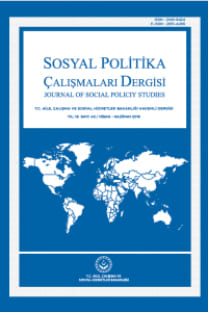Ankara İlinden Seçilen Sağlık Ocağı ve Ana Çocuk Sağlığı ve Aile Planlaması (Açsap) Bölgelerindeki 15-49 Yaş Grubu Kadınların Sahip Oldukları Çocuk Sayısına Göre Kullandıkları Aile Planlaması Yöntemleri
Amaç: Bu çalışmada, Ankara İlinden seçilen sağlıkocağı ve AÇSAP bölgelerindeki 1 5-49 Yaş Kadın İzlemFormlarının değerlendirilmesiyle, kadınların sahip olduklarıçocuk sayılarına göre, kullandıkları aile planlamasıyöntemlerinin belirlenmesi amaçlanmıştır.Yöntem: Bu çalışmanın verileri 2000 yılına ait 15-49Yaş Kadın İzlem Formlarından elde edilmiştir. AraştırmadaAnkara iline bağlı Yenimahalle 1 Nolu AÇSAP (13415form), Polatlı AÇSAP (9535 form), Saray Sağlık Ocağı(1298 form), Uyanış Sağlık Ocağı (584 form), 9 NoluSağlık Ocağı (3028 form) değerlendirmeye alınmıştır.Formlardan kadınların sahip oldukları çocuk sayıları vekullandıkları aile planlaması yöntemleri belirlenmiştir.İstatistiksel değerlendirmelerde ki-kare önemlilik testiuygulanmış ve Epi-info versiyon 6.0 istatistik paketprogramı kullanılmıştır.Bulgular: Modern yöntemlerin kullanımı %52.4, etkisizyöntemlerin kullanımı ise %12.6'dır. İncelenenlerin%4.2'si yöntem kullanmamaktadır. Modern yöntemlerdenen çok RİA (%42.8), ikinci ve üçüncü sırada ise kondom(%17.0) ve hap (%12.1) kullanılmaktadır. Bekar olanlarınhiçbiri yöntem kullanmamaktadır. Kadınların sahip olduklarıçocuk sayısına yöntem kullanma durumları arasındaistatistiksel olarak anlamlı fark bulunmuştur(p<0.05).Sonuç: Bu çalışma ile saptanmış olan, aile planlamasıyöntemi kullanma sıklığı sahip olunan çocuk sayısınagöre kullanılan aile planlaması yöntemleri 1998 Türkiye,Nüfus Sağlık Araştırması sonuçlarına göre Türkiyeiçin saptanmış olan sonuçlara oldukça benzerdir. Ancakmodern yöntemler Türkiye için saptanmış sonuçlara göredaha fazla kullanılmaktadır.
With regard to Their Number of Children, the Family Planning Methods Using By Women Between Age 15-49 Living İn Selected Primary Health Care Service And Mother And Child Health Care-Family Planning Center Areas in Ankara
Objective: The aim of this study was to determine thefamily planning methods that, with regard to their number ofchildren, use the women between age 15-49, living inselected Primary Health Çare Center and Mother and ChildHealth Care-Family Planning Center areas in Ankara. Forthis study, the follow-up special document forms of womenbetween age 15-49 of the selected areas were investigated.Method: The data of this study were obtained from theyear 2000 records of the follow-up special document formsofwomen betıveen age 15-49. Yenimahalle No 1 Mother andChild Health Care-Family Planning Center (13415 forms),Polatlı Mother and Child Health Care-Family Planning Center(9535 forms), Saray Primary Health Çare Center (1298forms), Uyaniş Primary Health Çare Center (584), No 9 PrimaryHealth Çare Center (3028 forms) were included to this study.The number of children that each woman ha ve, and, thefamily planning methods that they use were determined fromthese forms. İn s tat istical evaluations, Epi-lnfo version 0.6statistical packet program was used and Chi Sguare test wasapplicated.Results: The use of modern methods was 52.4%, theuse of ineffective methods was 12.6%. The 4.2% of theinvestigated women were not us İng any methods. Among themodern methods IUD was the most commonly used method(42.8%), in the second and third rank were condom (17.0%)and o rai contraceptives (12.1%). No ne of the single womenwere using any contraceptive methods. There was astatistically significant diffe rence between the status of usingany contraceptive methods of the women with regard to theirnumber of children (p<0.05).Conclusion: The freguency of using any familyplanning methods, the methods using with regard to thenumber of children that the women ha ve, determined withthis study, were quite simi/ar to the results that 1998 Türk is hDemographic Health Survey was determined for Turkey.Otherwise, modern methods were using more than theresults determined for Turkey.
